Sharks, often portrayed as fearsome predators in popular culture, are vital components of marine ecosystems and the most vulnerable. In fact, over one-third of shark species are considered threatened with extinction, mainly due to overfishing. Despite their pointy teeth and size, their significance extends beyond mere apex predators. The environmental impact of sharks is profound, playing a crucial role in maintaining the health and balance of oceanic ecosystems.
Keystone Species: Balancing the Marine Ecosystem
Sharks are considered “keystone species” because of their pivotal role in maintaining the structure and function of marine ecosystems. Without keystone species, ecosystems would rapidly change, or worse, disappear. As top predators, sharks regulate populations of prey species, preventing them from overgrazing on essential marine habitats such as coral reefs and seagrass beds.
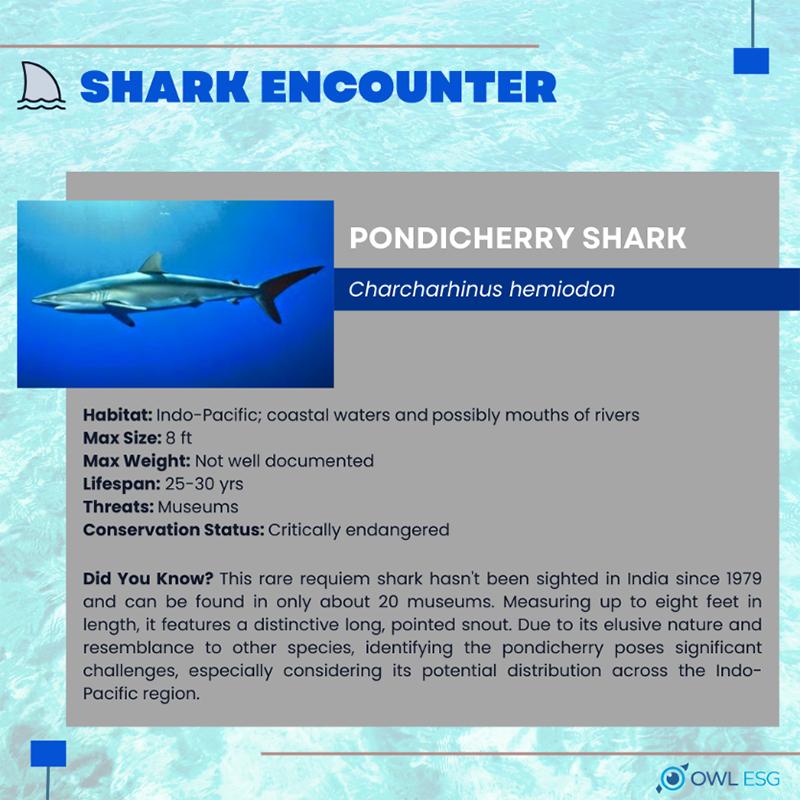
Seagrass is important for the ocean ecosystem because it traps carbon dioxide (CO2) and helps stabilize the sediments on the ocean floor that store the gas. After CO2 becomes trapped in the sediments, it can remain there for tens of thousands of years. Sharks change mitigation by supporting carbon sequestration in marine habitats, which are important carbon sinks. Additionally, sharks themselves store significant amounts of carbon (roughly 10-15 percent), and studies reveal that the depletion of large aquatic species like whales and sharks has reduced the ocean’s capacity to store carbon by millions of tons, worsening atmospheric pollution, accelerating global warming.
As we struggle to discover eco-friendly alternatives to widely polluting human practices, the impacts of climate change are becoming increasingly evident. Particularly striking are the consequences unfolding beneath the waves, where deep-sea predators are facing rapid declines. A recent study in the Journal of Animal Ecology suggests that this trend is poised to worsen habitat degradation more than any other factor.
Shark Bay
With over 500 known shark species, there is a wide range in size, prey preferences, and habitats, making it challenging to pinpoint the impact of a single species. As a result, past efforts to study these creatures affect their ecosystems.
However, research conducted in Shark Bay, Australia indicates that sharks contribute to their ecosystems not primarily as predators, but as regulators. This location is ideal for scientists because of its seasonal tiger sharks. Here, they’re able to observe how other animals behave when tigers are and aren’t present.Latest research from the Journal of Animal Ecology tackled this issue, despite the already observed 70 percent decline in their numbers. In Shark Bay, tiger sharks primarily prey on seacows (AKA dugongs). If the shark population were to vanish completely, seacow numbers would surge, leading to a rapid increase in demand for seagrass, a vital component of their diet. This heightened demand, already damaged by rising temperatures due to climate change, would worsen existing pressures on its availability.
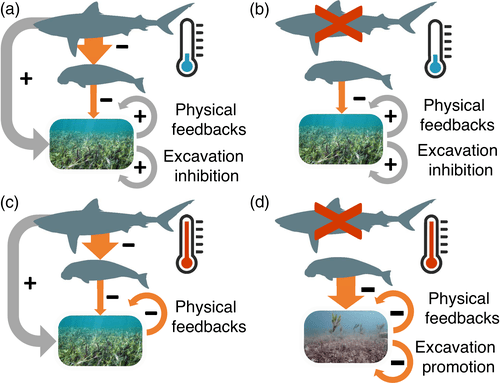
With soaring temperatures and a surge in seacow numbers, seagrass regeneration would lag. This shortfall would lead to the decline of other seagrass-dependent species and displacement of those relying on seagrass meadows for shelter. Ultimately, this cascading effect would harm seacows and disrupt biodiversity significantly.
Shark Bay has also provided insights into how sharks could enhance ecosystem resilience in the face of climate change. For instance, during a severe marine heat wave in 2011, roughly 90 percent of Shark Bay’s temperate seagrass was destroyed, leaving the remaining vegetation highly susceptible to further damage.
By controlling the abundance of prey species, sharks help maintain the delicate balance of marine food webs, ensuring the stability and resilience of oceanic ecosystems. And while Shark Bay may be a hotspot for studying these apex predators, rather than focusing solely on sharks’ roles, scientists need to study all aspects of the ecosystem to gain true understanding into how to best preserve the ocean.
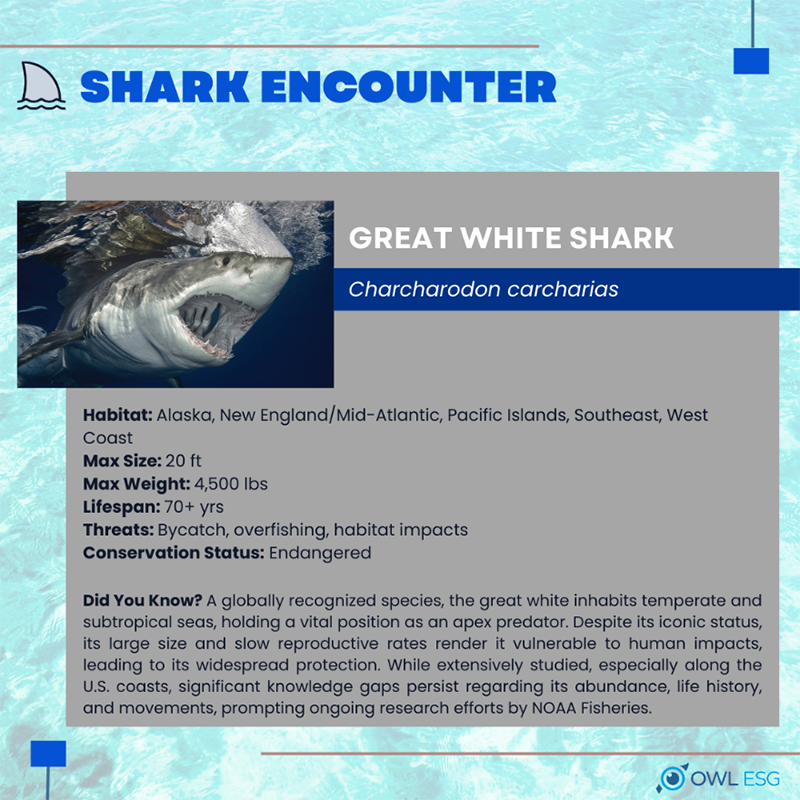
Warming Oceans’ Impact on Shark Survival
The impacts of climate change on the world’s oceans are vast and diverse, with ongoing and future effects expected to be significant. We can potentially face:
- A projected warming of 2.6-4.8 °C by 2100.
- A predicted decrease in pH of 0.4 units by 2100.
- Reductions in dissolved oxygen levels, leading to increased occurrences of oxygen-depleted ‘dead spots.’
- Fluctuations in salinity based on location, influenced by factors such as temperature rise and shifts in ocean currents.
Studies suggest the implications of these changes for wildlife and ecosystems pose challenges for highly mobile marine species like sharks. Unlike mammals, most sharks are ectothermic, meaning their body temperature aligns with their environment, allowing them to perform basic functions optimally. While controlled lab settings facilitate precise temperature response measurements, studying climate change impacts on larger marine animals presents logistical challenges due to their inability to be maintained in labs. Nonetheless, new field techniques provide opportunities to estimate such connections.
For example, the Shark Research & Conservation Program (SRC) at the University at Miami aims to understand the relationship between sharks and water temperatures. Using different methods, the SRC team evaluated the effects of ocean warming on tiger shark movements in the Western North Atlantic. The study revealed that over the past 40 years, sharks have moved north due to rising temperatures. Satellite tracking data from the last decade indicated extended migrations poleward, with earlier arrivals in warm periods. Potential consequences of these climate-driven changes include increasing shark vulnerability to fishing, disruption of predator-prey interactions, and changes in encounters with humans in the water.
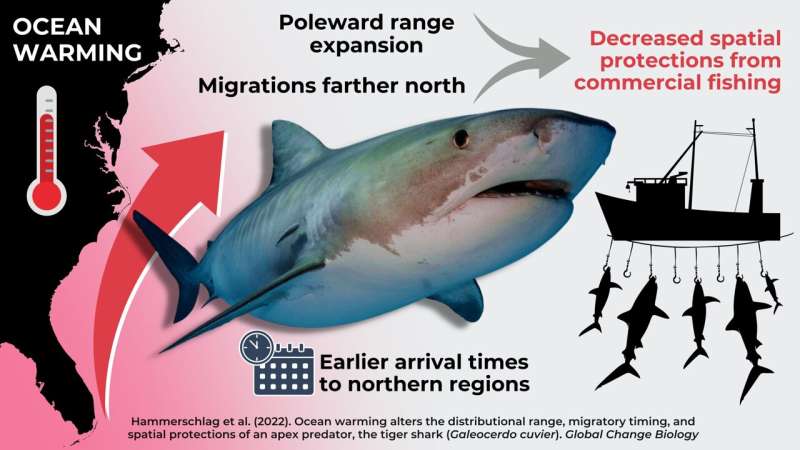
Since tiger sharks are shifting their movements outside of marine protected areas, they’re becoming more vulnerable to commercial fishing. And, because of climate change, water temperatures and levels are rising as well as acidity.
Another important factor is understanding the range of responses within species to stressors when determining the traits ( i.e., size, local adaptation to fluctuating chemical and physical conditions, and age-at-maturity) that increase the vulnerability of individuals and groups of elasmobranchs to environmental change.
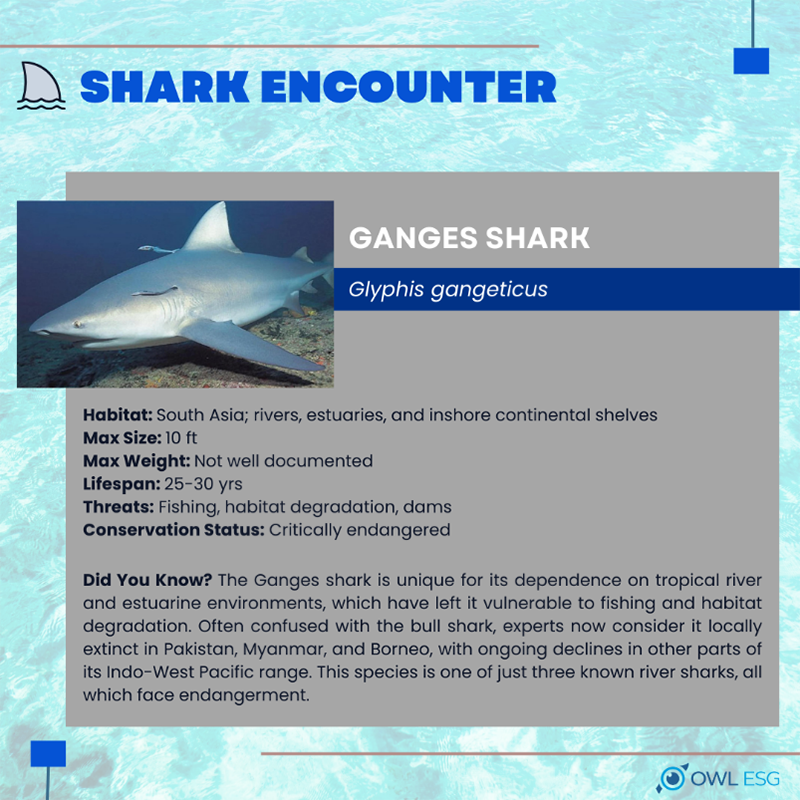
Locomotor performance is a vital trait, which determines fitness and is closely related to the morphology of limbs responsible for it, like fins. In elasmobranchs, it affects essential functions including reproduction, migration, predator avoidance, and small-scale movements.
Valentia Di Santo, Assistant Professor of Functional Morphology at Stockholm University, is currently investigating the impacts of climate change on elasmobranchs in her latest research project. One of the most intriguing discoveries is the impact of ocean acidification on the skeletal density of elasmobranchs.
Ocean acidification results from extended CO2 absorption from fossil fuel burning and land use practices like agriculture. Di Santo states that increased CO2 levels lead to enhanced skeletal mineralization in modified pelvic fins of skates and the jaws, the opposite effect that’s commonly observed in shell-forming invertebrates, ultimately altering buoyancy and locomotor performance.
While ocean warming decreases mineralization in pectoral fins, crucial for swimming in skates, it may impair large-scale movements due to heavier skeletons (from ocean acidification) and less stiff pectoral fins (from warming) in future ocean conditions.
Maintaining Biodiversity, Ecosystems, and Coral Reefs
The existence of sharks contributes to the preservation of species diversity within marine ecosystems. With an assorted diet consisting of fish, crustaceans, and even other sharks, they prevent certain species from dominating the ecosystem, allowing a diverse array of marine life to thrive.
For instance, sharks influence the behavior and distribution of prey through fear, ensuring the survival of smaller fish diversity, including grazers like parrotfish and turtles. By regulating prey populations, sharks prevent overgrazing of habitats, such as turtles consuming seagrass meadows. These grazers keep coral healthy by preventing algae overgrowth, which can lead to reef degradation and death. Without sharks, turtles increase their grazing, leading to rapid degradation of crucial habitats.
Coral reefs also benefit from these apex predators because they help maintain their health by sustaining food webs and fish populations, cycling nutrients, mitigating disease, and regulating invasive species.
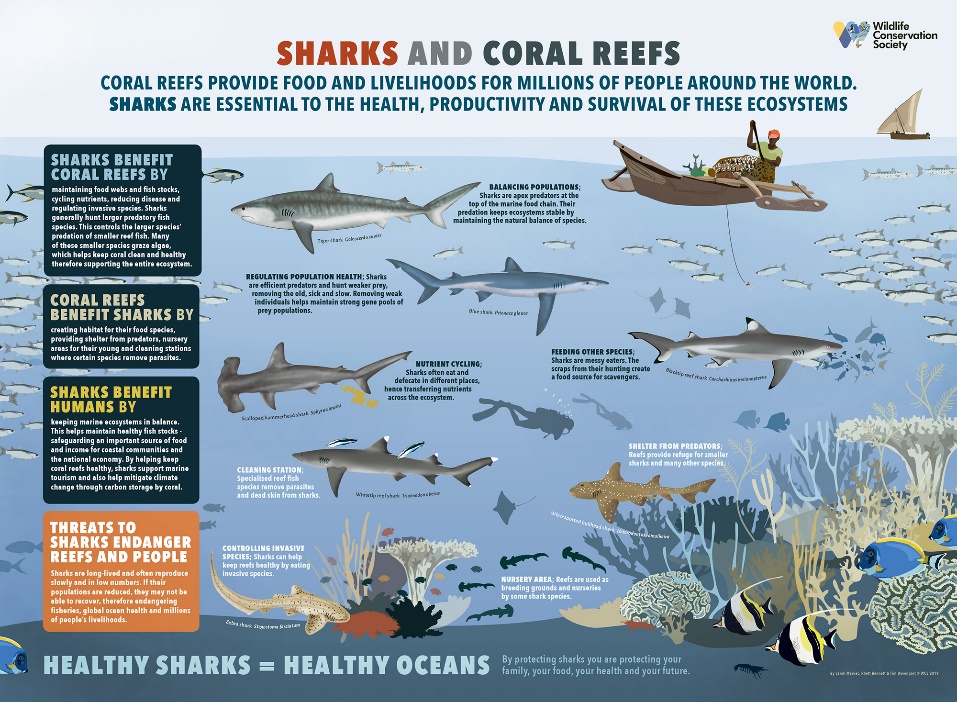
Though, the decline of sharks in coral reef environments has led to an increase in smaller species preying on herbivorous fish, resulting in a decline in herbivore populations, this imbalance allows algae to grow, transforming coral-dominated reefs into algae-dominated ones and ultimately leading to decreased biodiversity and reduced resilience to disturbances like coral bleaching and storms.
FIN-ishing Recap
- Sharks are keystone species which regulate prey populations and prevent overgrazing on essential habitats like coral reefs and seabeds.
- Sharks contribute to carbon sequestration which helps mitigate climate change impacts.
- Warmer water is forcing sharks to move north for breeding and feeding.
- Sharks help maintain coral reefs and contribute to the preservation of species diversity within marine ecosystems.
- Climate change, habitat loss, and overfishing pose significant challenges to shark survival.
Sharks Under Pressure: Fishing and Overfishing – Part 2
Get ready for an eye-opening dive into the world of shark conservation with part two: “Sharks Under Pressure: Fishing and Overfishing.” Discover the critical challenges these magnificent creatures encounter in their quest for survival.


